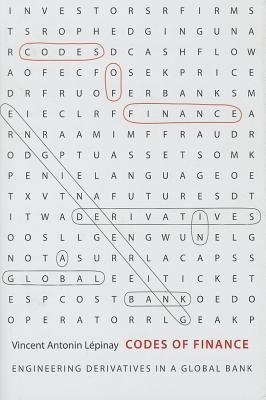Codes of Finance: Engineering Derivatives in a Global Bank by Vincent Antonin Lepinay

PART I
From Models to Books
We start our journey into financial engineering by scrutinizing the product.
This close focus has one objective: understanding how the theoretical
imaginings of financial engineers become financial services, which are then
maintained by traders on actual Exchanges. The development of new
products is one of the secret steps of market operations. The genesis of
products is protected because that is where the know-how of the engineers
shows itself the most clearly. For the bank to survive and attract new
clients, new financial services must embody new possibilities for investors
and their money. Banks are in a race against other financial service firms,
but they are also in a race against themselves: they have to survive the
tyranny of the formula they have sold and make sure that when the time
comes, they can return the client’s capital and its formula-based
performance.
CGPs are synthetic products drawing on existing securities. As
compilations of outstanding financial products twisted by the formula, they
need to be outfitted with their own models. The appeal of the product— as a
combination of insurance and investment—also creates the central puzzle
that the trading room wrestles with: finding the model that suits the product.
Given that this articulation is the source of major difficulties in the trading
room, it is worth clarifying the terms of the product/model dance using an
older derivative.
A “call” on a listed stock, traded on an Exchange, is a product designed
to meet what are supposed to be needs of a class of clients. The description
of a “call” can assume many forms, but when a client wants to buy one, he
or she is usually handed a series of documents that contain the following
information:
A definition:
A call option is a contract that gives the holder the right (“the option”
not the obligation) to buy a certain quantity of an underlying security
from the writer of the option, at a specified price (strike price) up to a
specified date (expiration date).
A formula of its payoff:
Call option payoff = Max (0, [Underlying price – Strike price]).
With the definition and the formula, a visual representation of the
call’s value is also usually offered [see figure 3].
The simplicity of its payoff is disarming: one underlying and a linear
deduction of the call’s value. This instrument derives its value from a
mechanical relation between a price, defined by the contracting parties, and
a fluctuating price, beyond the parties’ control. Nothing else interferes in
the value of the call: the whole economy could go wild, but as long as the
underlying exhibits a price, the call has a value. When the term of the
product has come due, the owner of such a contract can say how much
Codes of Finance: Engineering Derivatives in a Global Bank by Vincent Antonin Lepinay




